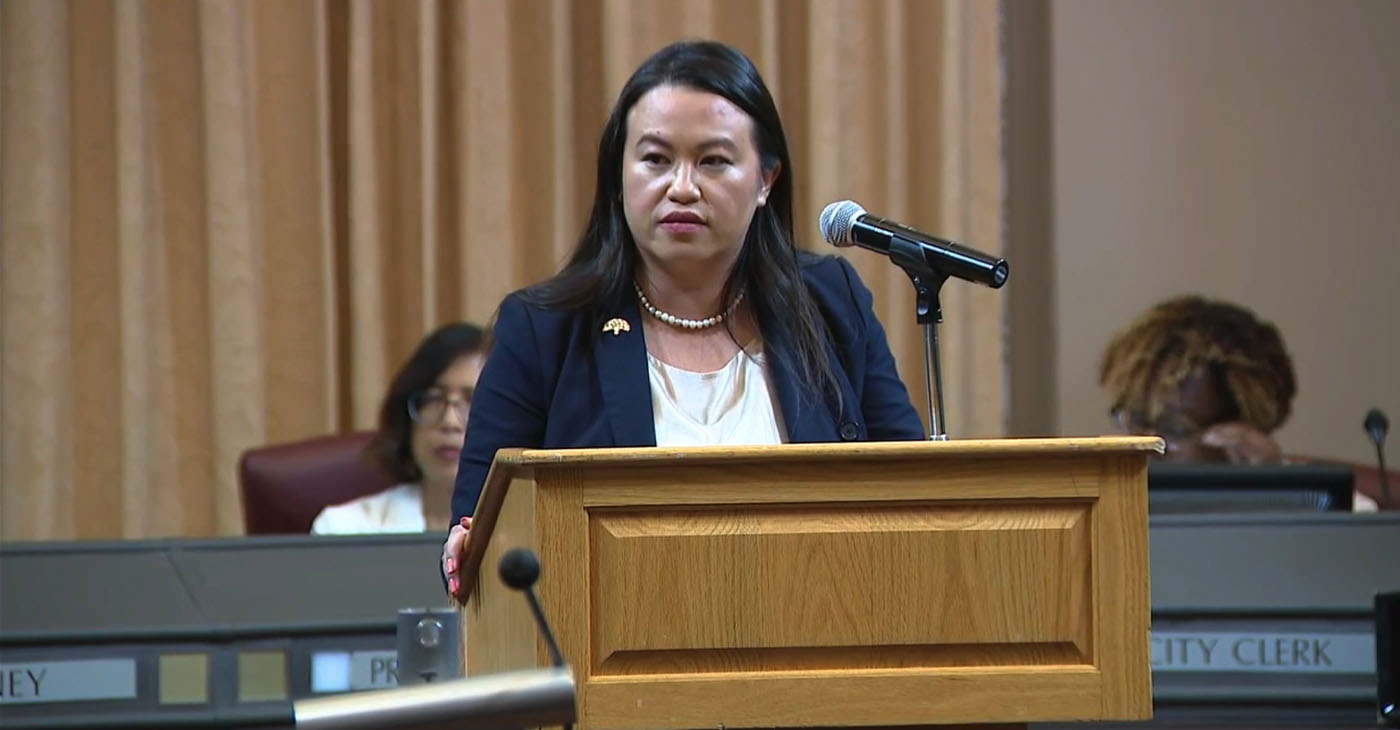Bay Area
Oakland Mayor Sheng Thao Faces Recall Efforts One Year Into Term
A group of Oakland residents, dissatisfied with Mayor Sheng Thao’s approach to combating crime and ensuring public safety, have initiated a recall campaign against her, one year into her term. The recall campaign is being led by Brenda Harbin-Forte, a former Alameda County Superior Court judge, who was removed from the Oakland Police Commission by Thao last year in June.

By Magaly Muñoz
A group of Oakland residents, dissatisfied with Mayor Sheng Thao’s approach to combating crime and ensuring public safety, have initiated a recall campaign against her, one year into her term.
The recall campaign is being led by Brenda Harbin-Forte, a former Alameda County Superior Court judge, who was removed from the Oakland Police Commission by Thao last year in June.
Residents have been reported to be “fed up” with Thao’s perceived lack of action in addressing crime and public safety issues in the city, mainly citing the past year’s events with Oakland Police Department (OPD).
The notice of intent that was submitted over the weekend asserts that firing OPDs Police Chief LeRonne Armstrong has led to a spike in violent crimes and has created a public safety crisis that has led to “the city’s reputation as one of the most dangerous in America.”
The notice of intent adds that Thao has failed to appoint a new police chief in nearly a year after Armstrong’s dismissal and has also failed to declare a state of emergency in the city which she promised in September to do if a police chief had not been hired by the end of the year.
“Lives have been lost, property destroyed, businesses have shut down, and fear and collective trauma are daily occurrences for Oaklander,” the letter states. “We, the concerned citizens, therefore demand your recall for the sake of our city’s future.”
Armstrong was dismissed in February by Thao over allegations of mishandling officer misconduct cases. In December, the Police Commission submitted his name to Thao to be considered for reinstatement to the position along with two other candidates but the mayor rejected all three candidates and asked the commission to propose new ones delaying hiring a chief until March.
According to end of year OPD reports, all crime increased by 17% from 2022 to 2023; violent crime rose by 21%; robbery by 38%; burglary by 23%; and motor vehicle theft by 45%.
Soon after firing the chief, Thao and her administration also failed to submit an application for crime fighting funds that would’ve given Oakland an estimated $15 million for additional police patrols, squad cars, and automated license plate readers to track down suspected perpetrators of crime.
Thao acknowledged these mistakes in her State of the City address in October, saying that “the buck stops with me” and that her main objective as mayor is to ensure public safety in the community.
In response to the recall efforts, Thao said she wants people to come together and fight for the city they love.
“I have the best job in the world. That’s because every day I have a chance to fight for a safer, more affordable, and more prosperous Oakland,” Thao said in a statement. “I ask all Oaklanders to help me achieve that vision with hope and collaboration and push aside fear and division.”
Her chief of staff, Leigh Hanson, also issued a statement against those attempting to recall the mayor.
“This recall effort is led by losers. Men who ran against her for mayor and lost. I know for a fact that if Mayor Thao had lost the election, she would have conceded gracefully and found a legitimate job that contributed to moving our community forward,” Hanson said.
Hanson added that she believes the Oakland community is “smarter than this” and “will resist the urge to be distracted by a desperate attempt for relevance.”
In an unrelated note, Thao is not the only elected official in the Bay Area facing a recall campaign. Alameda District Attorney Pamela Price is also under scrutiny, with recall organizers accusing her of being “soft on crime” as theft, robberies and shoplifting have increased over the last year.
Organizers have 160 days to gather signatures from 10%, or about 25,000, registered voters in Oakland to get the recall onto the ballot.
Activism
Oakland Post: Week of May 21 – 27, 2025
The printed Weekly Edition of the Oakland Post: Week of May 21 – 27, 2025

To enlarge your view of this issue, use the slider, magnifying glass icon or full page icon in the lower right corner of the browser window.
Bay Area
Chevron Richmond Installs Baker Hughes Flare.IQ, Real-time Flare Monitoring, Control and Reduction System
While the sight of flaring can cause concern in the community, flares are essential safety systems that burn pollutants to prevent them from being released directly into the atmosphere. They activate during startup and shut-down of facility units or during upsets or equipment malfunctions. The typical flare stack is about 200 feet high so that vapors are well above street levels.

The Richmond Standard
Chevron Richmond recently installed flare.IQ, a real-time, automated system that will improve the facility’s flaring performance.
The technology, developed by Panametrics, a Baker Hughes business, uses sensors to monitor, reduce and control flaring in real time. It collects and assesses data on refinery processes, such as temperature, pressure, gas flow and gas composition, and adjusts accordingly to ensure flares burn more efficiently and cleanly, leading to fewer emissions.
“The cleaner the flare, the brighter the flame can look,” said Duy Nguyen, a Chevron Richmond flaring specialist. “If you see a brighter flame than usual on a flare, that actually means flare.IQ is operating as intended.”
While the sight of flaring can cause concern in the community, flares are essential safety systems that burn pollutants to prevent them from being released directly into the atmosphere. They activate during startup and shut-down of facility units or during upsets or equipment malfunctions. The typical flare stack is about 200 feet high so that vapors are well above street levels.
“A key element in Baker Hughes’ emissions abatement portfolio, flare.IQ has a proven track record in optimizing flare operations and significantly reducing emissions,” said Colin Hehir, vice president of Panametrics, a Baker Hughes business. “By partnering with Chevron Richmond, one of the first operators in North America to adopt flare.IQ, we are looking forward to enhancing the plant’s flaring operations.”
The installation of flare.IQ is part of a broader and ongoing effort by Chevron Richmond to improve flare performance, particularly in response to increased events after the new, more efficient hydrogen plant was brought online in 2019.
Since then, the company has invested $25 million — and counting — into flare minimization. As part of the effort, a multidisciplinary refinery team was formed to find and implement ways to improve operational reliability and ultimately reduce flaring. Operators and other employees involved in management of flares and flare gas recovery systems undergo new training.
“It is important to me that the community knows we are working hard to lower emissions and improve our flaring performance,” Nguyen said.
Also evolving is the process by which community members are notified of flaring incidents. The Community Warning System (CWS), operated by Contra Costa County is an “all-hazard” public warning system.
Residents can opt-in to receive alerts via text, e-mail and landline. The CWS was recently expanded to enable residents to receive notifications for “Level 1” incidents, which are considered informational as they do not require any community action.
For more information related to these topics, check out the resources included on the Chevron Richmond, CAER and Contra Costa Health websites. Residents are also encouraged to follow @chevronrichmond and @RFDCAOnline on Facebook and X (formerly Twitter), where additional information may be posted during an incident.
Activism
Oakland Hosts Town Hall Addressing Lead Hazards in City Housing
According to the city, there are 22,000 households in need of services for lead issues, most in predominantly low-income or Black and Latino neighborhoods, but only 550 to 600 homes are addressed every year. The city is hoping to use part of the multimillion-dollar settlement to increase the number of households served each year.

By Magaly Muñoz
The City of Oakland’s Housing and Community Development Department hosted a town hall in the Fruitvale to discuss the efforts being undertaken to remove lead primarily found in housing in East and West Oakland.
In 2021, the city was awarded $14 million out of a $24 million legal settlement from a lawsuit against paint distributors for selling lead-based paint that has affected hundreds of families in Oakland and Alameda County. The funding is intended to be used for lead poisoning reduction and prevention services in paint only, not water or other sources as has been found recently in schools across the city.
The settlement can be used for developing or enhancing programs that abate lead-based paint, providing services to individuals, particularly exposed children, educating the public about hazards caused by lead paint, and covering attorney’s fees incurred in pursuing litigation.
According to the city, there are 22,000 households in need of services for lead issues, most in predominantly low-income or Black and Latino neighborhoods, but only 550 to 600 homes are addressed every year. The city is hoping to use part of the multimillion-dollar settlement to increase the number of households served each year.
Most of the homes affected were built prior to 1978, and 12,000 of these homes are considered to be at high risk for lead poisoning.
City councilmember Noel Gallo, who represents a few of the lead-affected Census tracts, said the majority of the poisoned kids and families are coming directly from neighborhoods like the Fruitvale.
“When you look at the [kids being admitted] at the children’s hospital, they’re coming from this community,” Gallo said at the town hall.
In order to eventually rid the highest impacted homes of lead poisoning, the city intends to create programs and activities such as lead-based paint inspections and assessments, full abatement designed to permanently eliminate lead-based paint, or partial abatement for repairs, painting, and specialized cleaning meant for temporary reduction of hazards.
In feedback for what the city could implement in their programming, residents in attendance of the event said they want more accessibility to resources, like blood testing, and information from officials about lead poisoning symptoms, hotlines for assistance, and updates on the reduction of lead in their communities.
Attendees also asked how they’d know where they are on the prioritization list and what would be done to address lead in the water found at several school sites in Oakland last year.
City staff said there will be a follow-up event to gather more community input for programming in August, with finalizations happening in the fall and a pilot launch in early 2026.
-

 Activism4 weeks ago
Activism4 weeks agoAI Is Reshaping Black Healthcare: Promise, Peril, and the Push for Improved Results in California
-

 Activism4 weeks ago
Activism4 weeks agoBarbara Lee Accepts Victory With “Responsibility, Humility and Love”
-

 Activism4 weeks ago
Activism4 weeks agoESSAY: Technology and Medicine, a Primary Care Point of View
-

 Activism4 weeks ago
Activism4 weeks agoFaces Around the Bay: Author Karen Lewis Took the ‘Detour to Straight Street’
-

 Arts and Culture4 weeks ago
Arts and Culture4 weeks agoBOOK REVIEW: Love, Rita: An American Story of Sisterhood, Joy, Loss, and Legacy
-

 Activism4 weeks ago
Activism4 weeks agoNewsom Fights Back as AmeriCorps Shutdown Threatens Vital Services in Black Communities
-

 #NNPA BlackPress4 weeks ago
#NNPA BlackPress4 weeks agoThe RESISTANCE – FREEDOM NOW
-

 Activism4 weeks ago
Activism4 weeks agoTeachers’ Union Thanks Supt. Johnson-Trammell for Service to Schools and Community













































